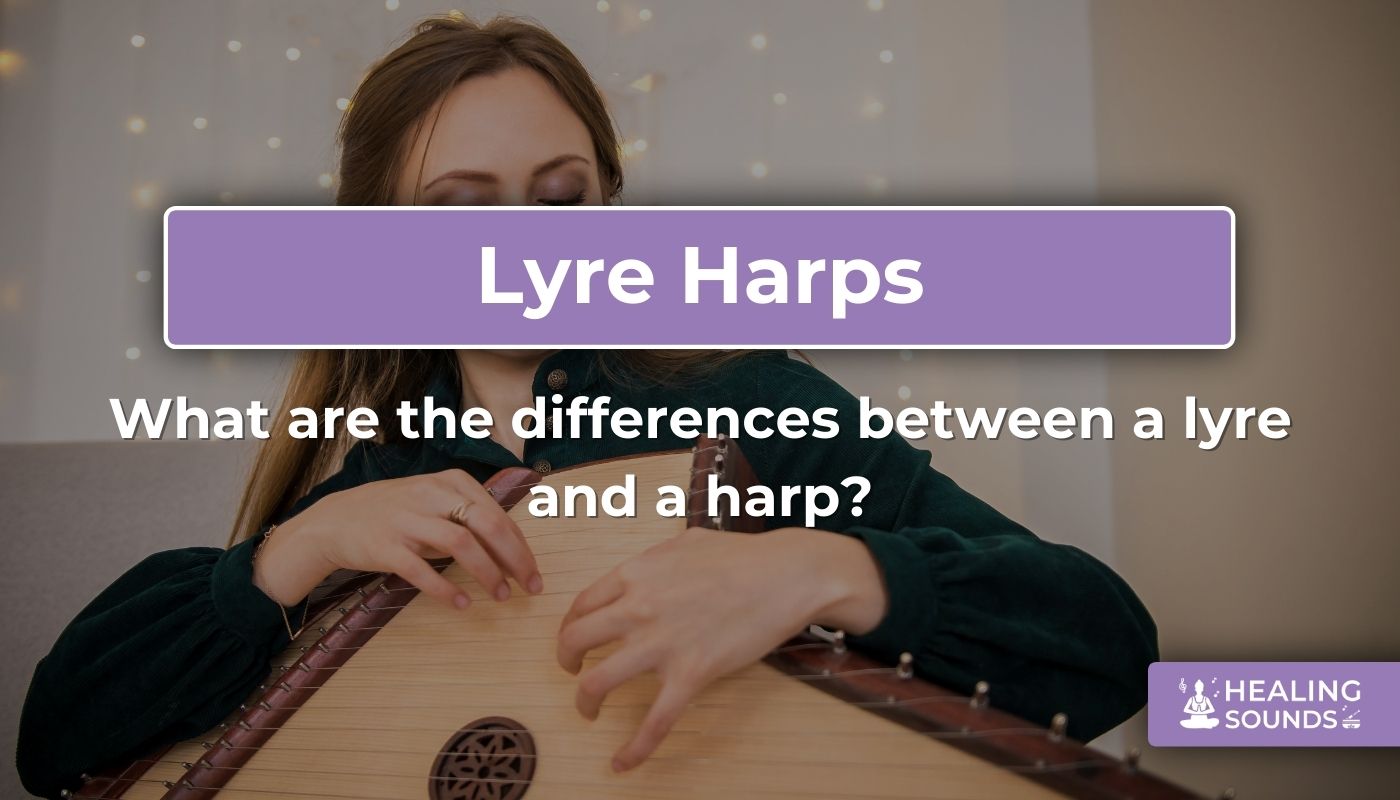The world of stringed musical instruments is rich with history and enchanting sounds, particularly appealing to those seeking tools for relaxation and healing. Among these captivating instruments, the lyre instrument and the harp often spark curiosity and sometimes confusion. While both create beautiful melodies by plucking strings, they possess distinct identities. Understanding the nuances of lyre vs harp is key for any music enthusiast, especially those drawn to the therapeutic potential of healing music. This exploration will delve into the unique characteristics of each instrument, helping you discover which one might resonate best with your musical and wellness journey.
What Makes a Lyre a Lyre?
The lyre instrument boasts an ancient lineage, echoing through millennia of musical tradition across various cultures. Its iconic structure typically features a resonant body or soundbox, two arms extending upwards, and a crossbar (yoke) connecting the arms, to which the strings are attached. This simple yet elegant design contributes to its unique sonic footprint.
Lyres are celebrated for their often ethereal and soothing tones, capable of evoking a sense of calm and intimacy. This distinct acoustic quality makes the healing lyre a popular choice for personal meditation and sound therapy practices. Its sound is generally lighter and less sustained than a harp's, offering a delicate, plucked quality.
- Often compact and highly portable Lyre designs are common.
- Available in various string counts (from 7 to over 20).
- Historically associated with storytelling, poetry, and contemplative music.
- Relatively straightforward playing technique, accessible for beginners.
Exploring the gentle voice of the lyre reveals why it remains a cherished instrument for those seeking tranquility through sound.
The Majestic Harp: Sound and Structure
In contrast to the lyre's intimate scale, the harp often presents a more imposing figure within the family of stringed musical instruments. Characterized typically by its triangular frame – consisting of a soundbox, neck, and pillar – the harp usually supports a greater number of strings, ranging from smaller lap harps to large orchestral pedal harps.
The harp is renowned for its rich, resonant, and sweeping sound, capable of producing complex harmonies and melodies. Its full-bodied tones can fill a space, creating an immersive soundscape ideal for performance, relaxation, and therapeutic settings. From the traditional **Celtic harp** to modern concert grands, the acoustic harp offers a vast expressive range.
Important attributes include:
- A wide range of notes, enabling complex musical arrangements.
- Larger harps often feature pedals or levers for changing keys quickly.
- A prominent instrument in orchestral, folk, and therapeutic music traditions.
The harp's grandeur and versatility make it a captivating instrument for both players and listeners.
Lyre vs Harp: Unpacking the Core Differences
While both are plucked string instruments often used for healing music, the fundamental distinctions in lyre vs harp lie in their construction, sound, and historical context.
Structural Distinctions
The most apparent difference is size and shape. The lyre instrument is generally smaller, lighter, and defined by its arms-and-yoke structure holding the strings away from the soundboard. This often makes it a more portable Lyre option. Harps, conversely, have strings running perpendicularly from the soundboard up to the neck, housed within a larger triangular frame, which provides greater tension and volume.
Sound Quality and Resonance
Sound is where the divergence is most felt. A lyre typically produces a lighter, quieter, and more plucked sound with quicker decay – ideal for delicate melodies and intimate settings. The harp generates a fuller, louder, more sustained tone with significant resonance, suitable for lush harmonies and filling larger spaces. The greater number of strings on most harps also allows for a wider tonal range.
Historical Context & Common Usage
The lyre has deep roots in antiquity, famously depicted in Ancient Greek art and mythology. Historically, it accompanied poetry and song. When asking "Did David play a harp or lyre?", historical consensus points towards an ancient lyre-like instrument known as the Kinnor. The harp, while also ancient, evolved significantly, with forms like the **Celtic harp** becoming integral to folk traditions and larger pedal harps securing a place in classical orchestras and modern sound therapy.

23-String Lyre Harp Instrument with Levers
$479.90 $623.90
This lyre harp blends portability with extended range, featuring levers for chromatic notes, perfect for exploring diverse melodies in your healing music practice.
Explore This Lever Lyre HarpWhich Instrument Resonates with You? Practical Considerations
Choosing between a lyre instrument and a harp is a personal journey influenced by practical factors and musical aspirations, especially when focusing on healing sounds.
Your Musical Goals & Environment
Consider your primary intention. Are you seeking a simple, portable instrument for personal meditation and quiet reflection? The lyre might be ideal. Or do you envision learning complex pieces, performing, or creating deeply immersive sound baths? A lap harp or even a larger lever harp could be more suitable, offering greater musical possibilities. Budget and available space are also key factors, as harps are generally larger and more costly than lyres.
The Role in Healing and Relaxation
Both instruments excel in therapeutic contexts. The lyre's gentle, ancient-sounding tones can be incredibly grounding and calming, perfect for reducing anxiety and facilitating mindfulness. Its simplicity can be inviting for those new to playing music for wellness.
The harp's rich resonance and capacity for lush harmonies can induce deep relaxation and emotional release. Its vibrations are often described as enveloping and profoundly soothing. The field of music therapy often utilizes harps for their extensive capabilities. For more information on music therapy practices, consider resources like the American Music Therapy Association (AMTA).
- Portability Needs: Lyre wins for ease of transport.
- Musical Complexity: Harp offers a wider range and harmonic potential.
- Budget: Lyres are generally more affordable.
- Desired Sound: Ethereal & intimate (Lyre) vs. Rich & resonant (Harp).
- Healing Goal: Gentle calming (Lyre) vs. Deep immersion (Harp).
Explore Our Portable Lyre Harp Collection

17 String Rosewood Lyre Harp Instrument by Hluru
$59.90
$79.90
A beautiful and affordable entry into the world of healing lyre sounds, crafted from resonant rosewood. Learn more ➔

24 String Lyre Harp Instrument with Steel Strings
$89.90
$116.90
Experience a brighter tone and extended range with this 24-string lyre harp, ideal for varied musical exploration. Learn more ➔

16-String Lyre Harp Instrument with Butterfly Design
$69.90
$90.90
A visually charming and accessible lyre instrument, perfect for beginners seeking soothing sounds and artistic expression. Learn more ➔
Conclusion
The journey into the world of the lyre instrument and the harp reveals two distinct paths to musical expression and healing. The choice in the lyre vs harp comparison ultimately depends on your individual preferences, goals, and how you wish to engage with healing music. The lyre offers intimacy, portability, and ancient charm, while the harp provides grandeur, resonance, and vast musical potential.
Both are beautiful stringed musical instruments capable of creating profound sound experiences. At Healing Sounds, we are passionate about providing high-quality lyres and harps designed to support your exploration of sound, relaxation, and well-being. We invite you to explore our collection and find the instrument that truly speaks to your soul.
Frequently Asked Questions about Lyre vs Harp
No, a harp and a lyre instrument are not the same, although both are string instruments. Key differences include structure (lyres typically have arms and a yoke; harps have a triangular frame), size (harps are generally larger), string attachment (perpendicular to soundboard on harps, parallel on many lyres), and sound (harps are usually louder and more resonant).
Most scholars and historical depictions suggest King David played an instrument called the "Kinnor," which is considered a type of ancient lyre, not a harp as we typically envision it today. Lyres were common in the region during that historical period.
Assuming this question meant "lyre" instead of "liar": The primary difference between a harp and a lyre instrument lies in their structure and sound. Harps are typically larger, triangular instruments with strings running perpendicular to the soundboard, producing a rich, resonant sound. Lyres are often smaller, with strings attached to a crossbar (yoke) held by two arms, creating a lighter, more delicate tone.
A lyre instrument is defined by its characteristic structure: a soundbox (resonator body), two arms extending from the body, and a crossbar (yoke) connecting the tops of the arms. The strings typically run from the soundbox or a tailpiece up to this yoke. This design differentiates it from harps and lutes.
You can purchase quality lyre instruments and harps (including lyre harps) from specialized music stores and online retailers. Healing Sounds offers a curated selection of lyres and related instruments specifically chosen for their quality and suitability for healing music and relaxation.

